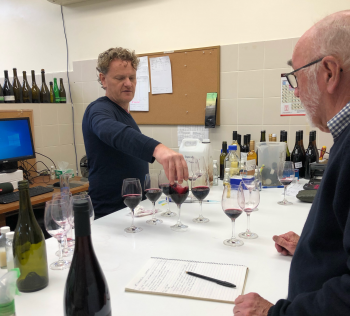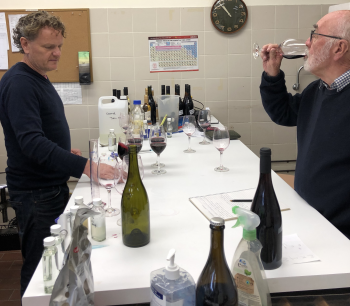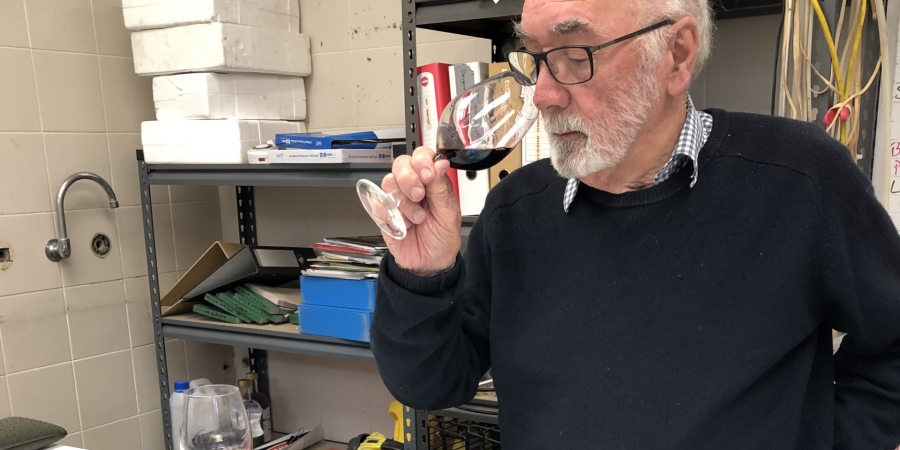 As I mentioned last week, we’ve got a couple of new vintages ready to head down the bottling line in a couple of weeks.
As I mentioned last week, we’ve got a couple of new vintages ready to head down the bottling line in a couple of weeks.
There are a handful of really important steps that need to happen before our 2018 Shiraz and 2019 Tempranillo are ready to do that though.
The first is something called “fining”. And before you can do that you need to do a “fining trial”.
Which is exactly what Rob has been doing in the lab this week (with Lodestone winemaker Michael Sykes in this picture).
Fining
Fining agents react with all the unrequired compounds in the wine (like the leftover yeast cells which can cause cloudiness). They bind to these compounds and form clumps which sink to the bottom of the tank. This makes them easier to remove.
Commonly-used fining agents include…
- Gelatine
- Isinglass (derived from fish!)
- Egg albumen
- Casein
- Skim Milk
- Bentonite
- Carbon
- Polyvinylpolypyrrolidone (PVPP)
The quantity and type of agent used can cause subtle changes in the structure and taste of a wine. So it takes a very experienced and skillful winemaker (luckily we have one of those!) to choose the right one.
To figure out exactly how much and which one should be used for each wine you need to do a “fining trail”.
 The best way to do that is to…
The best way to do that is to…
- go and get a sample of wine from the tank or barrel
- keep some aside as a “control” (something you can come back to, to see exactly how the flavour has changed from the original)
- share the rest out amongst some wine glasses and add different fining agents at different concentrations
- find a good winemaker to taste all the different samples to find the right fining agent and quantity!
It’s amazing how much some fining agents (depending on the wine) can alter the taste of the resulting wine. So, it’s tricky to find the right combination that does the job without impacting the wine too much. This is just another step in the process where Rob’s years of experience are put to good use!
I found this table on the AWRI website which gives an overview of each of the commonly used fining agents and what they tend to do to red and white wines. It’s a handy guide for winemakers, but also make for an interesting read (if you’re interested in that sort of thing!)…
Typical rates of additions of fining agents in white and red wine
| Type of product | Typical doses used (mg/L) |
Characteristics |
| White wine | ||
| Gelatine | 15 – 120 | Good clarity. Effective in reducing bitter after-taste. |
| Isinglass | 10 – 100 | Good clarity. Intensifies yellow colour. Light flakes, bulky, settles slowly. |
| Casein | 50 – 250 | Good clarification. Treats and prevents oxidation. No over fining. |
| Bentonite | 200 – 1000 | Average clarification. Treats and prevents protein instability and reduces the likelihood of copper casse. Facilitates settling. Avoids over fining. |
| Carbon | 50 – 2000 | Removes off-odours. Effective in colour reduction (browning and pinking). |
| PVPP | 100 – 800 | Effective in colour reduction (browning and pinking). Reduces bitterness. At high rates can result in colour and flavour stripping. |
| Red wine | ||
| Gelatine | 30 – 240 | Very good fining agent for tannic wines. Affects only the most aggressive tannins. May make wine softer or thinner. |
| Egg white (egg albumen) | 30 – 150 | Very good fining agent for tannic wines with some age. Tends not to remove protective colloids. |
| Casein | 50 – 250 | Good clarification. Treats and prevents oxidation. No over fining. |
| Bentonite | 200 – 500 | Clarification of young wines. Eliminates colloidal colouring matter. Facilitates sedimentation of protein fining agents. |
| Carbon | 50 – 2000 | Removes off-odours. Effective in colour reduction (browning and pinking). |
| PVPP | 100 – 450 | Reduces bitterness. Brightens colour. At high rates can result in colour and flavour stripping. |
Cold stabilisation
Have you ever drunk a wine and found what looks like shards of glass in the bottom of the bottle or, even worse, your glass? There’s no need panic… it’s not glass, but completely harmless and natural tartrate crystals which can form when a wine hasn’t been properly temperature stabilised. They are scientifically known as potassium bitartrate. If you’re a whizz in the kitchen you might also know them as cream of tartar!
Tartrates occur in wines when potassium and tartaric acid, both naturally occurring products of grapes, bind together to form a crystal. They are a normal bi-product of a wine as it ages, but cold temperatures can make them naturally combine with potassium to form a crystal.
The way to avoid this happening is to force this process in the winery before bottling. The tank is chilled down so far that ice forms on the outside and the tartrates form and sink to the bottom.
Filtration
So, now that we have all these clumps (!) and crystals in the wine, what to do with them?
The final step in the process is to pass the wine through a filter on its way to the bottling line. This will remove all those unwanted particles and leave us with a beautifully clean wine, ready to be enjoyed by you!
Sometimes, if during the fining trial none of the fining agents “add” anything to the wine in terms of structure or flavour (ie. if the wine is already amazing enough because it was made by Rob Moody), then the winemaker may choose not to use a fining agent and instead rely on the filtration process to ensure none of those “extra” compounds makes it into your glass.
And that is exactly what happened with the Shiraz and Tempranillo this week. Very little work in the lab was required to ensure these already sensational wines were ready for bottling! And we can’t wait to share them with you!
Champagne Shopping Morning!
It’s that time of year again!
If you’re a Jockey Club member, keep an eye on your inbox this afternoon for your official invitation to this special event.
This event sells out every single year, so make sure you get your tickets early. We always have such a lovely day of it!
